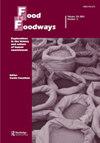多平行语料库中食物翻译的挑战:巴尔扎克人间喜剧中的饮料和用餐时间
IF 1.1
Q2 ANTHROPOLOGY
引用次数: 0
摘要
摘要19世纪的法国小说通过对美食和餐桌乐趣黄金时代的反思,以不同的方式回顾了饮食文化的各个方面。La Comédie Humaine是突出法国美食和美食基石的里程碑。在本研究中,我们通过考察食物术语及其英土耳其语翻译,对拉科梅迪·胡曼的21部小说进行了多阶段分析。我们的主要贡献是在巴尔扎克的背景下对食物进行定性和定量分析。我们从原始文本和翻译文本中进行了食品数据可视化,从而揭示了Comédie Humaine中饮料和用餐时间的术语是如何相互关联的,以及英语和土耳其语中的食品翻译可能会有什么不同,尤其是葡萄酒、咖啡术语和用餐时间名称的名称。我们通过土耳其和英国文化的视角,为巴尔扎克的小说提供了一种情境化的饮食方法,揭示了他们对法国饮食文化的开放性,与声望规则和目标文化的习惯有关。我们通过在源语言中本地化食物模式来开始我们的分析。然后,我们在远程阅读(定量数据分析)和近距离阅读(侧重于定性分析)中对它们进行了分析。这种混合方法提供了一层新的见解,可以推广到食品和文学领域的其他文本和语言。本文章由计算机程序翻译,如有差异,请以英文原文为准。
Challenges of translating food in multiparallel corpus: Beverages and mealtimes in Balzac’s human comedy (La Comédie Humaine)
Abstract French novels of the 19th century recall the aspects of food culture in different ways through their reflections on the golden age for both gastronomy and the pleasures of the table. La Comédie Humaine is a milestone in highlighting the keystones of French food and gastronomy. In this study, we propose a multistage analysis of 21 novels of La Comédie Humaine by examining the food terms and their translations into English and Turkish. Our main contribution is the qualitative and quantitative analysis of food in the Balzacian context. We have performed food data visualization from original and translated texts and thus revealed how the terms for beverages and mealtimes are interconnected in the Comédie Humaine and how food translations might differ in English and Turkish, especially the names of wine, coffee terms and mealtime names. We provide a contextualized food approach to Balzac’s novels through the lens of Turkish and English culture revealing their openness, or not, to French food culture, linked to the rules of prestige and the habitus of the target culture. We started our analysis by localizing food patterns in the source language. Then we analyzed them in distant reading – analysis of quantitative data – and close reading focused on the qualitative analysis. This mixed methodology gives a new layer of insight and could be extrapolated to other texts and languages in the domain of food and literature.
求助全文
通过发布文献求助,成功后即可免费获取论文全文。
去求助
来源期刊

Food and Foodways
ANTHROPOLOGY-
CiteScore
2.20
自引率
0.00%
发文量
16
期刊介绍:
Food and Foodways is a refereed, interdisciplinary, and international journal devoted to publishing original scholarly articles on the history and culture of human nourishment. By reflecting on the role food plays in human relations, this unique journal explores the powerful but often subtle ways in which food has shaped, and shapes, our lives socially, economically, politically, mentally, nutritionally, and morally. Because food is a pervasive social phenomenon, it cannot be approached by any one discipline. We encourage articles that engage dialogue, debate, and exchange across disciplines.
 求助内容:
求助内容: 应助结果提醒方式:
应助结果提醒方式:


